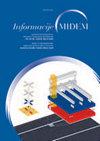HybridSELBOX无结FinFET的设计与性能分析
IF 0.8
4区 工程技术
Q4 ENGINEERING, ELECTRICAL & ELECTRONIC
Informacije Midem-Journal of Microelectronics Electronic Components and Materials
Pub Date : 2019-05-07
DOI:10.33180/INFMIDEM2019.104
引用次数: 0
摘要
本文采用数值模拟的方法分析了选择性埋藏氧化物无结晶体管(SELBOX-JL)在FinFET结构下的性能。所提出的结构具有较好的热阻(RTH),这是衡量自热效应(SHE)的指标。研究了该结构的直流和模拟性能,并与传统和混合(或反t) jlfinfet (jlt)进行了比较。由于采用了2d超薄体(UTB)、3D-FinFET和SELBOX等不同技术,混合SELBOX- JLFinFET的离子比JLT的离子要好1.43倍。利用sdevice对所提出的器件进行了建模,并进行了仿真研究。评估了各种模拟参数,如跨导(gm)、跨导产生因子(TGF = gm/IDS)、单位电流增益频率(fT)、早期电压(VEA)、总栅极电容(Cgg)和固有增益(A0)。最小特征尺寸为10nm的器件在工作深反转区表现出较好的TGF、fT、VEA和A0。本文章由计算机程序翻译,如有差异,请以英文原文为准。
Design and Performance Analysis of Hybrid
SELBOX Junctionless FinFET
In this work, the performance of selective buried oxide junction-less (SELBOX-JL) transistor at a FinFET structure is analysed
using numerical simulations. The proposed structure exhibits better thermal resistance (RTH), which is the measure of the self-heating
effect (SHE). The DC and analog performances of the proposed structure were studied and compared with the conventional and
hybrid (or inverted-T) JLFinFETs (JLTs). The ION of the hybrid SELBOX- JLFinFET is 1.43x times better than the ION of the JLT due to
the added advantage of different technologies, such as 2D-ultra-thin-body (UTB), 3D-FinFET, and SELBOX. The proposed device is
modeled using sprocess and simulation study is carried using sdevice. Various analog parameters, such as transconductance (gm),
transconductance generation factor (TGF = gm/IDS), unity current gain frequency (fT), early voltage (VEA), total gate capacitance (Cgg), and
intrinsic gain (A0), are evaluated. The proposed device with a minimum feature size of 10nm exhibited better TGF, fT, VEA, and A0 in the
deep-inversion region of operation.
求助全文
通过发布文献求助,成功后即可免费获取论文全文。
去求助
来源期刊
CiteScore
1.80
自引率
0.00%
发文量
10
审稿时长
>12 weeks
期刊介绍:
Informacije MIDEM publishes original research papers in the fields of microelectronics, electronic components and materials. Review papers are published upon invitation only. Scientific novelty and potential interest for a wider spectrum of readers is desired. Authors are encouraged to provide as much detail as possible for others to be able to replicate their results. Therefore, there is no page limit, provided that the text is concise and comprehensive, and any data that does not fit within a classical manuscript can be added as supplementary material.
Topics of interest include:
Microelectronics,
Semiconductor devices,
Nanotechnology,
Electronic circuits and devices,
Electronic sensors and actuators,
Microelectromechanical systems (MEMS),
Medical electronics,
Bioelectronics,
Power electronics,
Embedded system electronics,
System control electronics,
Signal processing,
Microwave and millimetre-wave techniques,
Wireless and optical communications,
Antenna technology,
Optoelectronics,
Photovoltaics,
Ceramic materials for electronic devices,
Thick and thin film materials for electronic devices.

 求助内容:
求助内容: 应助结果提醒方式:
应助结果提醒方式:


